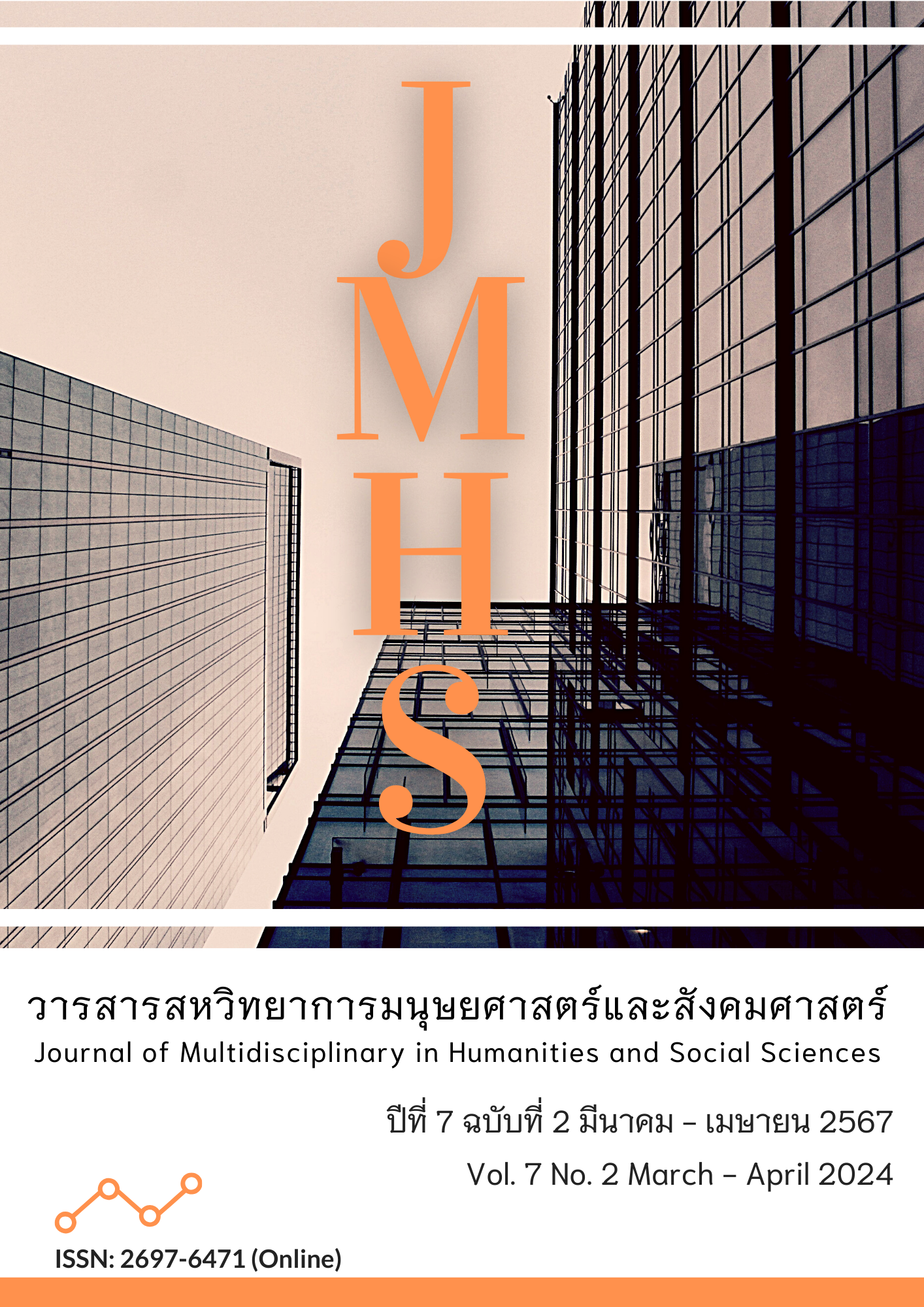The Model for Compliance with Core Competencies of Personnel at Koob Sub-District Administration Organization, Namkliang District, Sisaket Province
Main Article Content
Abstract
This article aimed to (1) study the model for compliance with the core competencies of personnel at Koob Sub-District Administrative Organization, Namkliang District, Sisaket Province, and (2) create a model and evaluate the compliance with the core competencies of personnel at Koob Sub-District Administrative Organization, Namkliang District, Sisaket Province, consisting of gender, age, and education. (1) It had a confidence value of 0.97. Analyze the data for frequency, percentage, mean, and standard deviation. (2) create a performance model based on the core competencies of Koob Sub-District Administrative Organization personnel, Namkliang District, Sisaket Province, by using factor analysis techniques; and (3) draft an assessment of performance models according to the model for compliance with the core competencies of personnel at Koob Sub-District Administrative Organization, Namkliang District, Sisaket Province. The sample group consists of professors with academic positions and human resource development experts. Using the assessment form, analyze the data to determine frequency, percentage, mean, and standard deviation.
The research results were found as follows: 1. The results of the study of the model for compliance with the core competencies of personnel at Koob Sub-District Administrative Organization, Namkliang District, Sisaket Province as a whole and in each aspect are at a high level. Sort the average score in descending order: notice of organization, ultimate determination, knowledge-based orientation, morality and integrity, and teamwork.
2. The results of creating the model for compliance with the core competencies of personnel at Koob Sub-District Administrative Organization, Namkliang District, Sisaket Province have five competencies: ultimate determination, knowledge-based orientation, morality and integrity, and teamwork.
3. The results of the assessment of the model for compliance with the core competencies of personnel at Koob Sub-District Administrative Organization, Namkliang District, Sisaket Province found that the accuracy of the operating model according to the model for compliance with the core competencies of personnel at Koob Sub-District Administrative Organization, Namkliang District, Sisaket Province as a whole is at a high level, and the suitability of the model for compliance with the core competencies of personnel at Koob Sub-District Administrative Organization, Namkliang District, Sisaket Province as a whole is at a high level. It has value to a large extent; it can be used.
Article Details

This work is licensed under a Creative Commons Attribution-NonCommercial-NoDerivatives 4.0 International License.
Views and opinions appearing in the Journal it is the responsibility of the author of the article, and does not constitute the view and responsibility of the editorial team.
References
กีรติ ยศยิ่งยง. (2549). ขีดความสามารถ. กรุงเทพฯ: มิสเตอร์ ก๊อปปี้ (ประเทศไทย).
จิรประภา อัครบวร. (2549). สร้างคนสร้างผลงาน. กรุงเทพฯ: ก. พลพิมพ์.
ชูชัย สมิทธิไกร. (2550). การสรรหา การคัดเลือก และการประเมินผลการปฏิบัติงานของบุคลากร. (พิมพ์ครั้งที่ 2). กรุงเทพฯ: จุฬาลงกรณ์มหาวิทยาลัย.
ณรงค์วิทย์ แสนทอง. (2550). มารู้จัก Competency กันเถอะ (พิมพ์ครั้งที่ 3). กรุงเทพฯ: เอช อาร์ เซ็นเตอร์.
ดวงเดือน จันทร์เจริญ. (2549). การใช้ Competency พัฒนาบุคลากร. วารสารการพัฒนาทรัพยากรมนุษย์, 2(1), 304-305. สืบค้นจาก http://www.hrdjournal.ru.ac.th/journals/viewIndex/5
ทิศนา แขมมณี. (2545). กลุ่มสัมพันธ์เพื่อการทำงานและการจัดการเรียนการสอน. กรุงเทพฯ: นิชินแอดเวอร์ไทซิ่ง กรุ๊ป.
ธีรวุฒิ เอกะกุล. (2543). ระเบียบวิธีวิจัยทางพฤติกรรมศาสตร์และสังคมศาสตร์. อุบลราชธานี: สถาบันราชภัฏอุบลราชธานี.
รัตนะ บัวสนธ์. (2552). การวิจัยแลพัฒนานวัตกรรมการศึกษา. กรุงเทพฯ: คำสมัย.
วนิดา ภูวนารถนุรักษ์. (2552). สมรรถนะของครูไทย. วารสารรามคำแหง, 26(ฉบับพิเศษ), 69-79.
ประไพทิพย์ ลือพงษ์. (2555). การพัฒนาทุนมนุษย์ให้มีความสามารถในการแข่งขัน. วารสารนักบริหาร, 32(4), 108-115.
ปัทมวรรณ สังขระชัฎ และ ชนินทร์ จักรภพโยธิน. (2563). การศึกษาสมรรถนะหลักขององค์การ: กรณีศึกษาบริษัทผลิตรถยนต์แห่งหนึ่ง. วารสารมนุษยศาสตร์และสังคมศาสตร์วไลยอลงกรณ์ ในพระบรมราชูปถัมภ์, 15(2), 137-145. สืบค้นจาก https://so06.tci-thaijo.org/index.php/vrurdihsjournal/article/view/243801/166905
ปรีชา เจนไพร. (2566). ประสิทธิผลของการนำนโยบายการพัฒนาสมรรถนะหลักของข้าราชการ สังกัดสำนักตรวจสอบป้องกันและปราบปราม กรมสรรพสามิต. วารสารการบริหารสาธารณะและการบริหารเอกชน, 1(1), 30-37. สืบค้นจาก https://so12.tci-thaijo.org/index.php/JPPMS/article/view/432
ไพรินทร์ ทองภาพ และสุรัติ สุพิชญางกูร. (2565). รูปแบบการพัฒนาขีดสมรรถนะหลักของแรงงานเพื่อตอบสนองความต้องการของอุตสาหกรรมเป้าหมาย S-curve ในกลุ่มอุตสาหกรรมอิเล็กทรอนิกส์ (Smart Electronics) ในเขตพัฒนาพิเศษภาคตะวันออก. วารสารคณะรัฐศาสตร์และนิติศาสตร์ มหาวิทยาลัยบูรพา, 14(1), 113-131. สืบค้นจาก https://ojs.lib.buu.ac.th/index.php/law/article/view/8396
สำนักงานคณะกรรมการข้าราชการพลเรือน (สำนักงาน ก.พ.). (ม.ป.ป.). มาตรฐานการกำหนดตำแหน่ง. สืบค้นจาก https://www.ocsc.go.th/job/specification
สำนักงานคณะกรรมการข้าราชการพลเรือน (สำนักงาน ก.พ.). (2553). คู่มือการกำหนดสมรรถนะในราชการพลเรือน: คู่มือสมรรถนะหลัก. นนทบุรี: ประชุมช่าง.
สุกัญญา รัศมีธรรมโชติ. (2551). แนวทางการพัฒนาศักยภาพมนุษย์ด้วย Competency based learning. (พิมพ์ครั้งที่ 6). กรุงเทพฯ: สถาบันเพิ่มผลผลิตแห่งชาติ.
สุรชัย พรหมพันธุ์. (2554). ชำแหละสมรรถนะเพื่อการพัฒนา Competency. กรุงเทพฯ: ปัญญาชน.
เอกชัย หลายชั้น และ มัทนา วังถนอมศักดิ์. (2558). สมรรถนะหลักของบุคลากรทางการศึกษาสังกัดมหาวิทยาลัยเทคโนโลยีราชมงคลรัตนโกสินทร์ วิทยาเขตวังไกลกังวล. วารสารบริหารการศึกษา มหาวิทยาลัยศิลปากร, 5(2), 135-144. สืบค้นจาก https://so02.tci-thaijo.org/ index.php/EdAd/article/view/66717
Cronbach, L. J. (1970). Essentials of psychological testing. New York: Harper & Row.
Krejcie, R. V., & Morgan, D. W. (1970). Determining sample size for research activities. Educational and Psychological Measurement, 30(3), 607–610.
Mckeen, J. D., & Smith, H. A. (2003). Making IT happen: Critical issues in IT management. West Sussex, England: Wiley.
Zhu, C., Wang, D., Cai, Y., & Engels, N. (2013). What Core Competencies are related to teachers’ innovative teaching. Asia-Pacific Journal of Teacher Education, 41(1), 9-27. DOI:10.1080/1359866X.2012.753984?journalCode=capj20


